engine FIAT FIORINO 2007 Owner handbook (in English)
[x] Cancel search | Manufacturer: FIAT, Model Year: 2007, Model line: FIORINO, Model: FIAT FIORINO 2007Pages: 210, PDF Size: 3.22 MB
Page 164 of 210
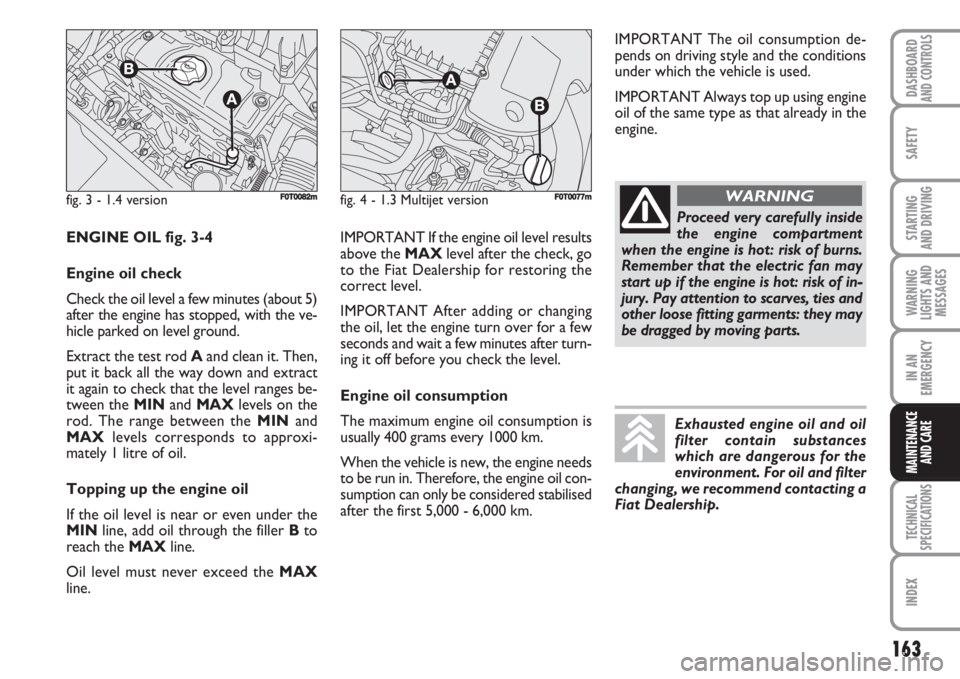
163
SAFETY
TECHNICAL
SPECIFICATIONS
INDEX
DASHBOARDAND CONTROLS
STARTING
AND DRIVING
WARNING
LIGHTS AND
MESSAGES
IN AN
EMERGENCY
MAINTENANCE
AND CARE
fig. 3 - 1.4 versionFF0T0082mfig. 4 - 1.3 Multijet versionF0T0077m
IMPORTANT The oil consumption de-
pends on driving style and the conditions
under which the vehicle is used.
IMPORTANT Always top up using engine
oil of the same type as that already in the
engine.
ENGINE OIL fig. 3-4
Engine oil check
Check the oil level a few minutes (about 5)
after the engine has stopped, with the ve-
hicle parked on level ground.
Extract the test rod Aand clean it. Then,
put it back all the way down and extract
it again to check that the level ranges be-
tween the MINand MAXlevels on the
rod. The range between the MINand
MAXlevels corresponds to approxi-
mately 1 litre of oil.
Topping up the engine oil
If the oil level is near or even under the
MINline, add oil through the filler Bto
reach the MAXline.
Oil level must never exceed the MAX
line.
Proceed very carefully inside
the engine compartment
when the engine is hot: risk of burns.
Remember that the electric fan may
start up if the engine is hot: risk of in-
jury. Pay attention to scarves, ties and
other loose fitting garments: they may
be dragged by moving parts.
WARNING
Exhausted engine oil and oil
filter contain substances
which are dangerous for the
environment. For oil and filter
changing, we recommend contacting a
Fiat Dealership.
IMPORTANT If the engine oil level results
above the MAXlevel after the check, go
to the Fiat Dealership for restoring the
correct level.
IMPORTANT After adding or changing
the oil, let the engine turn over for a few
seconds and wait a few minutes after turn-
ing it off before you check the level.
Engine oil consumption
The maximum engine oil consumption is
usually 400 grams every 1000 km.
When the vehicle is new, the engine needs
to be run in. Therefore, the engine oil con-
sumption can only be considered stabilised
after the first 5,000 - 6,000 km.
Page 165 of 210
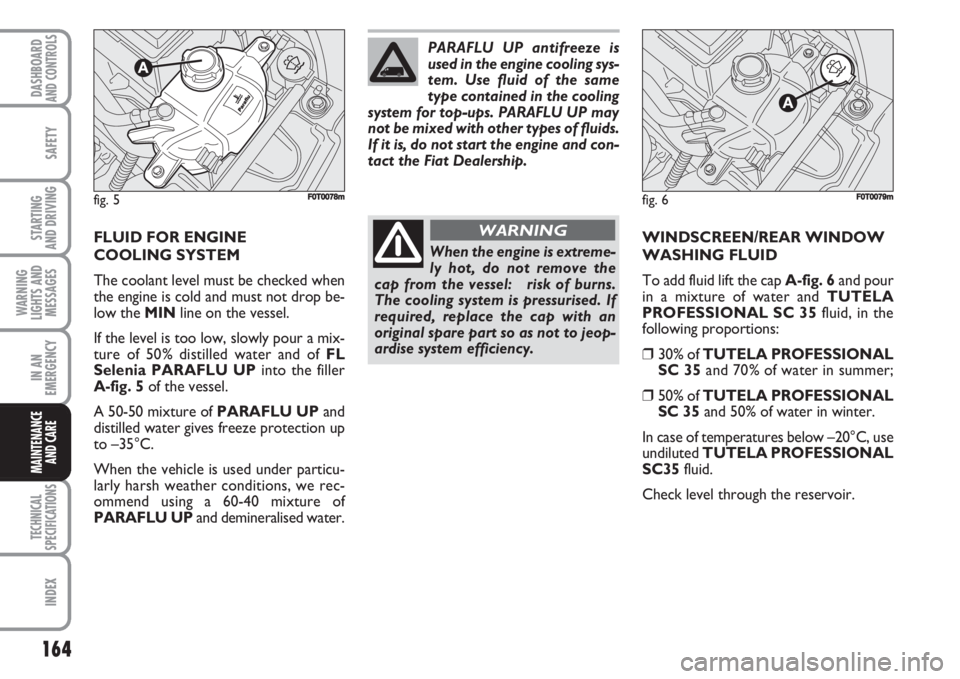
164
SAFETY
TECHNICAL
SPECIFICATIONS
INDEX
DASHBOARDAND CONTROLS
STARTING
AND DRIVING
WARNING
LIGHTS AND
MESSAGES
IN AN
EMERGENCY
MAINTENANCE
AND CARE
FLUID FOR ENGINE
COOLING SYSTEM
The coolant level must be checked when
the engine is cold and must not drop be-
low the MINline on the vessel.
If the level is too low, slowly pour a mix-
ture of 50% distilled water and of FL
Selenia PARAFLU UPinto the filler
A-fig. 5of the vessel.
A 50-50 mixture of PARAFLU UPand
distilled water gives freeze protection up
to –35°C.
When the vehicle is used under particu-
larly harsh weather conditions, we rec-
ommend using a 60-40 mixture of
PARAFLU UPand demineralised water.WINDSCREEN/REAR WINDOW
WASHING FLUID
To add fluid lift the cap A-fig. 6and pour
in a mixture of water and TUTELA
PROFESSIONAL SC 35fluid, in the
following proportions:
❒30% of TUTELA PROFESSIONAL
SC 35and 70% of water in summer;
❒50% of TUTELA PROFESSIONAL
SC 35and 50% of water in winter.
In case of temperatures below –20°C, use
undiluted TUTELA PROFESSIONAL
SC35fluid.
Check level through the reservoir.
fig. 5F0T0078m
When the engine is extreme-
ly hot, do not remove the
cap from the vessel: risk of burns.
The cooling system is pressurised. If
required, replace the cap with an
original spare part so as not to jeop-
ardise system efficiency.
WARNING
PARAFLU UP antifreeze is
used in the engine cooling sys-
tem. Use fluid of the same
type contained in the cooling
system for top-ups. PARAFLU UP may
not be mixed with other types of fluids.
If it is, do not start the engine and con-
tact the Fiat Dealership.
fig. 6FF0T0079m
Page 166 of 210
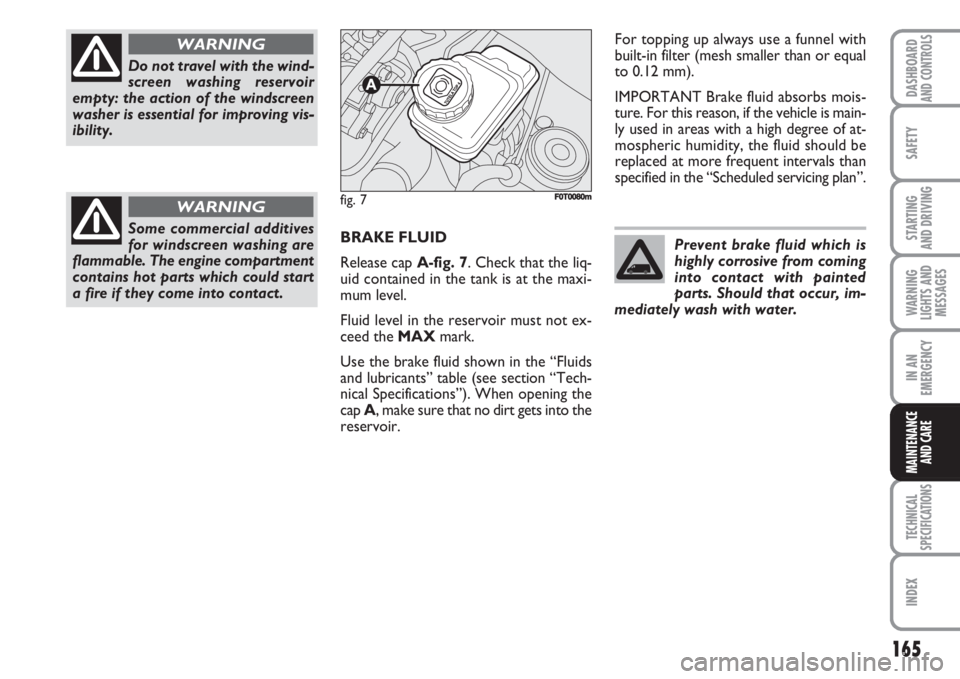
165
SAFETY
TECHNICAL
SPECIFICATIONS
INDEX
DASHBOARDAND CONTROLS
STARTING
AND DRIVING
WARNING
LIGHTS AND
MESSAGES
IN AN
EMERGENCY
MAINTENANCE
AND CARE
BRAKE FLUID
Release cap A-fig. 7. Check that the liq-
uid contained in the tank is at the maxi-
mum level.
Fluid level in the reservoir must not ex-
ceed the MAXmark.
Use the brake fluid shown in the “Fluids
and lubricants” table (see section “Tech-
nical Specifications”). When opening the
cap A, make sure that no dirt gets into the
reservoir.For topping up always use a funnel with
built-in filter (mesh smaller than or equal
to 0.12 mm).
IMPORTANT Brake fluid absorbs mois-
ture. For this reason, if the vehicle is main-
ly used in areas with a high degree of at-
mospheric humidity, the fluid should be
replaced at more frequent intervals than
specified in the “Scheduled servicing plan”.
Do not travel with the wind-
screen washing reservoir
empty: the action of the windscreen
washer is essential for improving vis-
ibility.
WARNING
Some commercial additives
for windscreen washing are
flammable. The engine compartment
contains hot parts which could start
a fire if they come into contact.
WARNINGfig. 7F0T0080m
Prevent brake fluid which is
highly corrosive from coming
into contact with painted
parts. Should that occur, im-
mediately wash with water.
Page 167 of 210
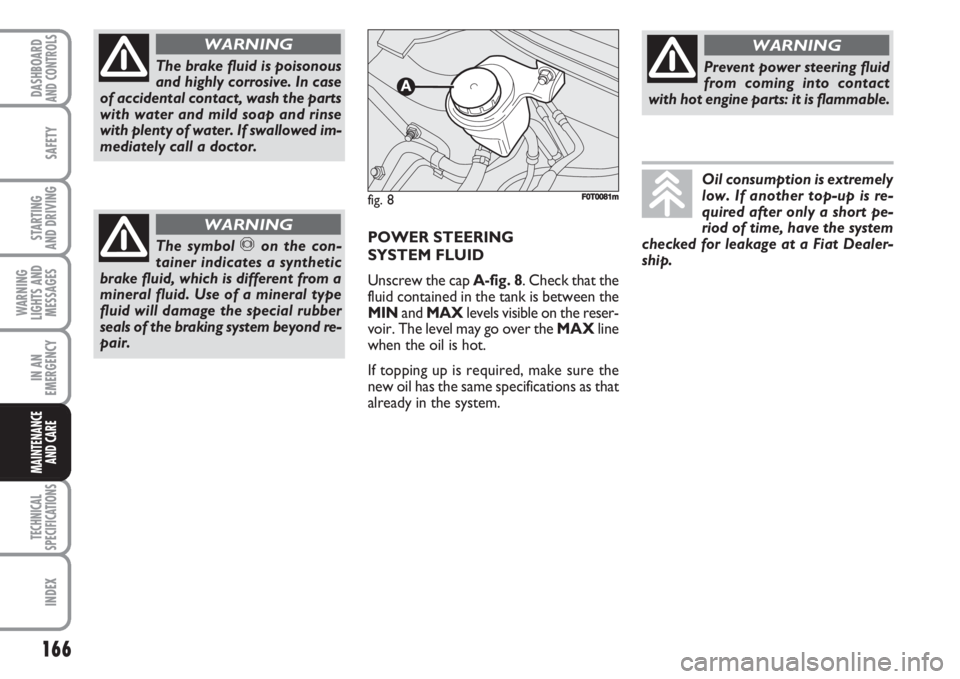
166
SAFETY
TECHNICAL
SPECIFICATIONS
INDEX
DASHBOARDAND CONTROLS
STARTING
AND DRIVING
WARNING
LIGHTS AND
MESSAGES
IN AN
EMERGENCY
MAINTENANCE
AND CARE
The brake fluid is poisonous
and highly corrosive. In case
of accidental contact, wash the parts
with water and mild soap and rinse
with plenty of water. If swallowed im-
mediately call a doctor.
WARNING
The symbol πon the con-
tainer indicates a synthetic
brake fluid, which is different from a
mineral fluid. Use of a mineral type
fluid will damage the special rubber
seals of the braking system beyond re-
pair.
WARNINGPOWER STEERING
SYSTEM FLUID
Unscrew the cap A-fig. 8. Check that the
fluid contained in the tank is between the
MINand MAXlevels visible on the reser-
voir. The level may go over the MAXline
when the oil is hot.
If topping up is required, make sure the
new oil has the same specifications as that
already in the system.
fig. 8F0T0081m
Prevent power steering fluid
from coming into contact
with hot engine parts: it is flammable.
WARNING
Oil consumption is extremely
low. If another top-up is re-
quired after only a short pe-
riod of time, have the system
checked for leakage at a Fiat Dealer-
ship.
Page 169 of 210
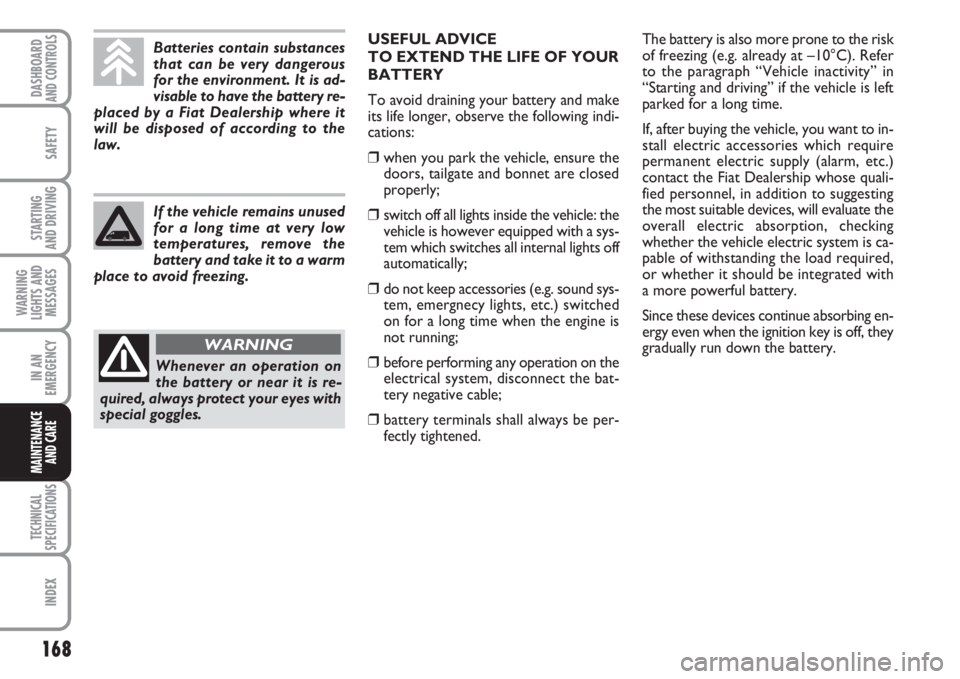
168
SAFETY
TECHNICAL
SPECIFICATIONS
INDEX
DASHBOARDAND CONTROLS
STARTING
AND DRIVING
WARNING
LIGHTS AND
MESSAGES
IN AN
EMERGENCY
MAINTENANCE
AND CARE
Batteries contain substances
that can be very dangerous
for the environment. It is ad-
visable to have the battery re-
placed by a Fiat Dealership where it
will be disposed of according to the
law.
Whenever an operation on
the battery or near it is re-
quired, always protect your eyes with
special goggles.
WARNING
If the vehicle remains unused
for a long time at very low
temperatures, remove the
battery and take it to a warm
place to avoid freezing.
USEFUL ADVICE
TO EXTEND THE LIFE OF YOUR
BATTERY
To avoid draining your battery and make
its life longer, observe the following indi-
cations:
❒when you park the vehicle, ensure the
doors, tailgate and bonnet are closed
properly;
❒switch off all lights inside the vehicle: the
vehicle is however equipped with a sys-
tem which switches all internal lights off
automatically;
❒do not keep accessories (e.g. sound sys-
tem, emergnecy lights, etc.) switched
on for a long time when the engine is
not running;
❒before performing any operation on the
electrical system, disconnect the bat-
tery negative cable;
❒battery terminals shall always be per-
fectly tightened.The battery is also more prone to the risk
of freezing (e.g. already at –10°C). Refer
to the paragraph “Vehicle inactivity” in
“Starting and driving” if the vehicle is left
parked for a long time.
If, after buying the vehicle, you want to in-
stall electric accessories which require
permanent electric supply (alarm, etc.)
contact the Fiat Dealership whose quali-
fied personnel, in addition to suggesting
the most suitable devices, will evaluate the
overall electric absorption, checking
whether the vehicle electric system is ca-
pable of withstanding the load required,
or whether it should be integrated with
a more powerful battery.
Since these devices continue absorbing en-
ergy even when the ignition key is off, they
gradually run down the battery.
Page 174 of 210
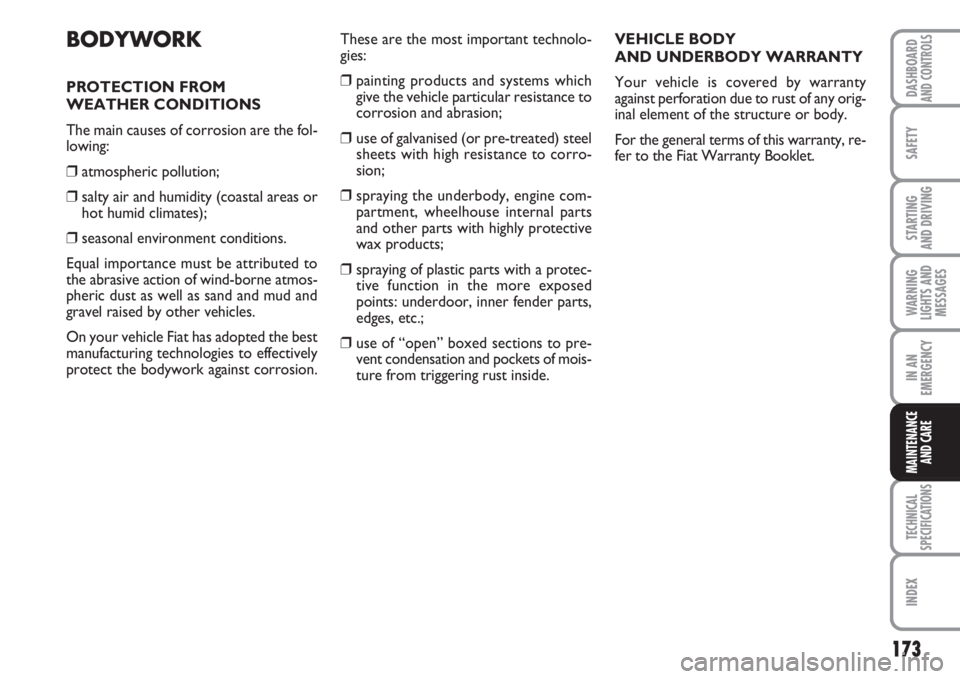
173
SAFETY
TECHNICAL
SPECIFICATIONS
INDEX
DASHBOARDAND CONTROLS
STARTING
AND DRIVING
WARNING
LIGHTS AND
MESSAGES
IN AN
EMERGENCY
MAINTENANCE
AND CARE
BODYWORK
PROTECTION FROM
WEATHER CONDITIONS
The main causes of corrosion are the fol-
lowing:
❒atmospheric pollution;
❒salty air and humidity (coastal areas or
hot humid climates);
❒seasonal environment conditions.
Equal importance must be attributed to
the abrasive action of wind-borne atmos-
pheric dust as well as sand and mud and
gravel raised by other vehicles.
On your vehicle Fiat has adopted the best
manufacturing technologies to effectively
protect the bodywork against corrosion.These are the most important technolo-
gies:
❒painting products and systems which
give the vehicle particular resistance to
corrosion and abrasion;
❒use of galvanised (or pre-treated) steel
sheets with high resistance to corro-
sion;
❒spraying the underbody, engine com-
partment, wheelhouse internal parts
and other parts with highly protective
wax products;
❒spraying of plastic parts with a protec-
tive function in the more exposed
points: underdoor, inner fender parts,
edges, etc.;
❒use of “open” boxed sections to pre-
vent condensation and pockets of mois-
ture from triggering rust inside.VEHICLE BODY
AND UNDERBODY WARRANTY
Your vehicle is covered by warranty
against perforation due to rust of any orig-
inal element of the structure or body.
For the general terms of this warranty, re-
fer to the Fiat Warranty Booklet.
Page 175 of 210
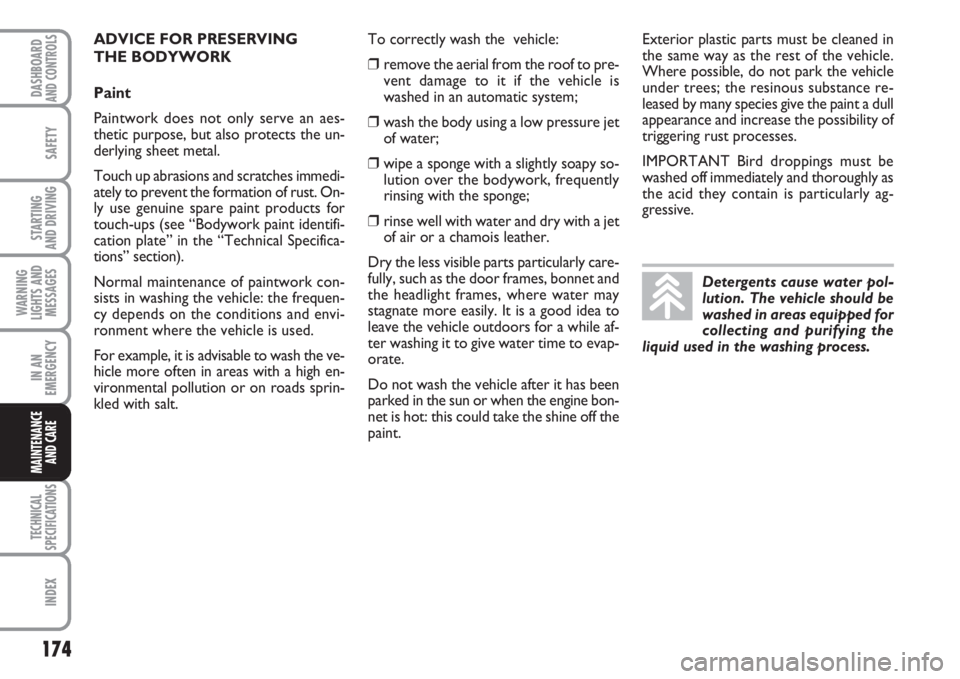
174
SAFETY
TECHNICAL
SPECIFICATIONS
INDEX
DASHBOARDAND CONTROLS
STARTING
AND DRIVING
WARNING
LIGHTS AND
MESSAGES
IN AN
EMERGENCY
MAINTENANCE
AND CARE
ADVICE FOR PRESERVING
THE BODYWORK
Paint
Paintwork does not only serve an aes-
thetic purpose, but also protects the un-
derlying sheet metal.
Touch up abrasions and scratches immedi-
ately to prevent the formation of rust. On-
ly use genuine spare paint products for
touch-ups (see “Bodywork paint identifi-
cation plate” in the “Technical Specifica-
tions” section).
Normal maintenance of paintwork con-
sists in washing the vehicle: the frequen-
cy depends on the conditions and envi-
ronment where the vehicle is used.
For example, it is advisable to wash the ve-
hicle more often in areas with a high en-
vironmental pollution or on roads sprin-
kled with salt.To correctly wash the vehicle:
❒remove the aerial from the roof to pre-
vent damage to it if the vehicle is
washed in an automatic system;
❒wash the body using a low pressure jet
of water;
❒wipe a sponge with a slightly soapy so-
lution over the bodywork, frequently
rinsing with the sponge;
❒rinse well with water and dry with a jet
of air or a chamois leather.
Dry the less visible parts particularly care-
fully, such as the door frames, bonnet and
the headlight frames, where water may
stagnate more easily. It is a good idea to
leave the vehicle outdoors for a while af-
ter washing it to give water time to evap-
orate.
Do not wash the vehicle after it has been
parked in the sun or when the engine bon-
net is hot: this could take the shine off the
paint.Exterior plastic parts must be cleaned in
the same way as the rest of the vehicle.
Where possible, do not park the vehicle
under trees; the resinous substance re-
leased by many species give the paint a dull
appearance and increase the possibility of
triggering rust processes.
IMPORTANT Bird droppings must be
washed off immediately and thoroughly as
the acid they contain is particularly ag-
gressive.
Detergents cause water pol-
lution. The vehicle should be
washed in areas equipped for
collecting and purifying the
liquid used in the washing process.
Page 176 of 210
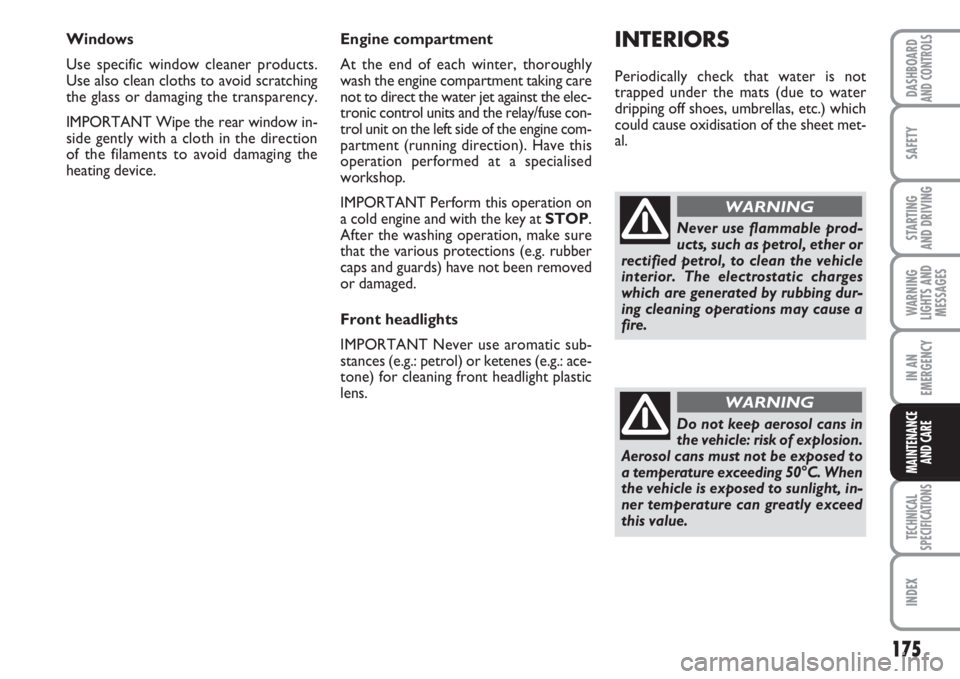
175
SAFETY
TECHNICAL
SPECIFICATIONS
INDEX
DASHBOARDAND CONTROLS
STARTING
AND DRIVING
WARNING
LIGHTS AND
MESSAGES
IN AN
EMERGENCY
MAINTENANCE
AND CARE
Windows
Use specific window cleaner products.
Use also clean cloths to avoid scratching
the glass or damaging the transparency.
IMPORTANT Wipe the rear window in-
side gently with a cloth in the direction
of the filaments to avoid damaging the
heating device.Engine compartment
At the end of each winter, thoroughly
wash the engine compartment taking care
not to direct the water jet against the elec-
tronic control units and the relay/fuse con-
trol unit on the left side of the engine com-
partment (running direction). Have this
operation performed at a specialised
workshop.
IMPORTANT Perform this operation on
a cold engine and with the key at STOP.
After the washing operation, make sure
that the various protections (e.g. rubber
caps and guards) have not been removed
or damaged.
Front headlights
IMPORTANT Never use aromatic sub-
stances (e.g.: petrol) or ketenes (e.g.: ace-
tone) for cleaning front headlight plastic
lens.INTERIORS
Periodically check that water is not
trapped under the mats (due to water
dripping off shoes, umbrellas, etc.) which
could cause oxidisation of the sheet met-
al.
Never use flammable prod-
ucts, such as petrol, ether or
rectified petrol, to clean the vehicle
interior. The electrostatic charges
which are generated by rubbing dur-
ing cleaning operations may cause a
fire.
WARNING
Do not keep aerosol cans in
the vehicle: risk of explosion.
Aerosol cans must not be exposed to
a temperature exceeding 50°C. When
the vehicle is exposed to sunlight, in-
ner temperature can greatly exceed
this value.
WARNING
Page 178 of 210

177
SAFETY
INDEX
DASHBOARDAND CONTROLS
STARTING
AND DRIVING
WARNING
LIGHTS AND
MESSAGES
IN AN
EMERGENCY
MAINTENANCE
AND CARE
TECHNICAL
SPECIFICATIONS
IDENTIFICATION DATA ................................................. 178
ENGINE CODES - BODYWORK VERSIONS............... 180
ENGINE .................................................................................. 181
FUEL FEED/IGNITION ....................................................... 182
TRANSMISSION .................................................................. 182
BRAKES................................................................................... 183
SUSPENSIONS ...................................................................... 183
STEERING .............................................................................. 183
WHEELS ................................................................................. 184
DIMENSIONS ....................................................................... 187
PERFORMANCE .................................................................. 189
WEIGHTS............................................................................... 190
CAPACITIES .......................................................................... 191
FLUIDS AND LUBRICANTS ............................................. 192
FUEL CONSUMPTION ...................................................... 194
CO
2EMISSIONS .................................................................. 195
RADIO FREQUENCY REMOTE CONTROL:
MINISTERIAL TYPE-APPROVALS ................................... 196
T T
E E
C C
H H
N N
I I
C C
A A
L L
S S
P P
E E
C C
I I
F F
I I
C C
A A
T T
I I
O O
N N
S S
Page 179 of 210
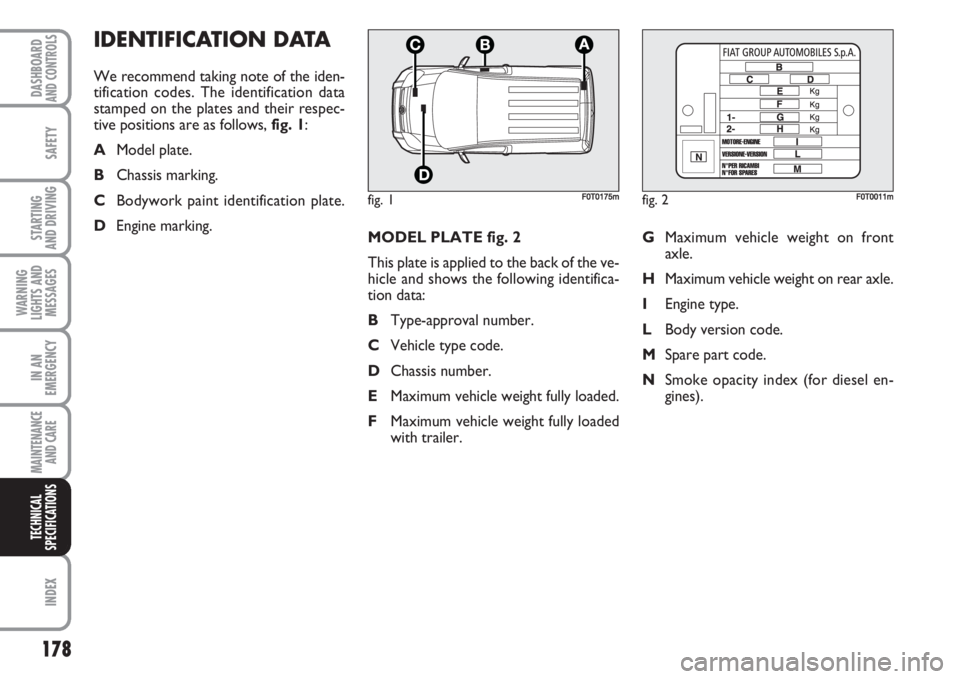
178
SAFETY
INDEX
DASHBOARDAND CONTROLS
STARTING
AND DRIVING
WARNING
LIGHTS AND
MESSAGES
IN AN
EMERGENCY
MAINTENANCE
AND CARE
TECHNICAL
SPECIFICATIONS
MODEL PLATE fig. 2
This plate is applied to the back of the ve-
hicle and shows the following identifica-
tion data:
BType-approval number.
CVehicle type code.
DChassis number.
EMaximum vehicle weight fully loaded.
FMaximum vehicle weight fully loaded
with trailer.GMaximum vehicle weight on front
axle.
HMaximum vehicle weight on rear axle.
IEngine type.
LBody version code.
MSpare part code.
NSmoke opacity index (for diesel en-
gines).
IDENTIFICATION DATA
We recommend taking note of the iden-
tification codes. The identification data
stamped on the plates and their respec-
tive positions are as follows, fig. 1:
AModel plate.
BChassis marking.
CBodywork paint identification plate.
DEngine marking.
fig. 1F0T0175mfig. 2F0T0011m